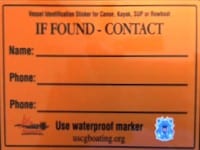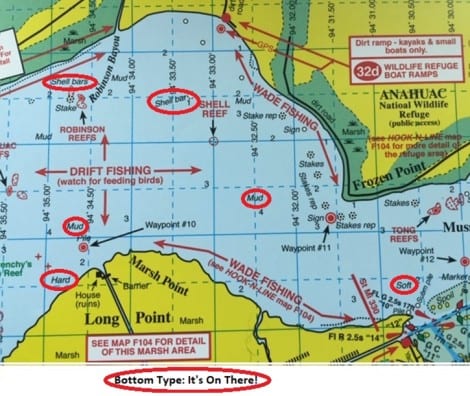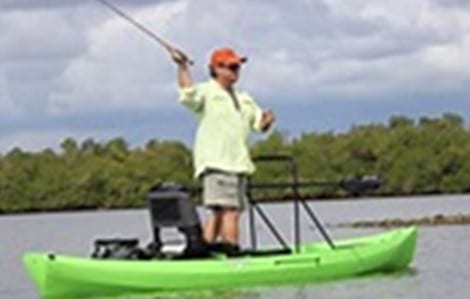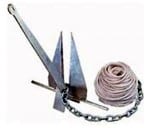
By Bob Currie, Recreational Boating Safety Specialist
U.S. Coast Guard Auxiliary Station Galveston Flotilla
When I bought my first kayak, it was with the intention of using it as a form of exercise as well as a way to enjoy the water. I had a pontoon boat that was a fishing model, and that is what I used when I wanted to go fishing. However, I found that most of the people I began recreational kayaking with also used their kayaks as a fishing platform, and I began joining them on fishing trips. I had the benefit of learning from very experienced and safety conscious kayakers, and I learned a lot about the challenges of fishing from a kayak rather than a much more stable boat. This column will be dedicated to the caveats for kayak fishermen specifically, but they are good for all kayakers to be aware of. I will start with the basic Coast Guard recommendations.
The Station Galveston Flotilla of the US Coast Guard Auxiliary operates out of the USCG Station Galveston base on Galveston Island. They aid the Coast Guard by providing maritime observation patrols in Galveston Bay; by providing recreational boating vessel safety checks; and by working alongside Coast Guard members in maritime accident investigation, small boat training, providing a safety zone, Aids to Navigation verification, in the galley, and watch standing.
Standard Kayak Safety Recommendations
- Wear a lifejacket at all times
- Have a good whistle (a sound-producing device is required by law)
- Don’t kayak alone
- Check the weather
- Attach an “IF FOUND-CONTACT” vessel identification sticker
- Have a communication device such as a cell phone or marine radio
- Have water and food in case you get stranded
- Dress for immersion
- Wear a hat and use sunscreen
- Wear shoes that will protect your feet from oyster shells
- Carry a knife in case you need to cut yourself free from entanglement
- Don’t overload your kayak

Minimize Your Fishing Equipment
You have surely seen the fishing kayakers whose boats looks like a porcupine due to all the fishing rods. They have multiple tackle boxes and gear hanging off in every direction. I dare say some exceed the weight limitation of their kayak in gear alone. If such a fisherman should flip their kayak, they will surely lose much of the gear, even if it is attached with lines to the kayak. It is easy to become entangled in such a mess and have to cut your way clear of the gear lines. Take a couple of different rods at most. I usually rig one for top water or popping cork and another for bottom fishing or freelining. I have a very small but organized tackle box. I load it with the type of hooks, lures, and plastic baits that I would need for the particular fish I am seeking. For me that is usually flounder, speckled trout, and redfish. Some people go kayak fishing for sharks and bull reds, and their tackle would be more substantial than mine. But there is no reason to carry your entire tackle collection with you on your kayak. I can place my small tackle box in my lap if I need to change something out rather than having to reach around to find something in a large tackle box attached to the rear platform. It is easy to become off-balance when turning around to find something on your rear platform, and that brings me to another point: the rear of your kayak is no place for your lifejacket. If you capsize, it will float away, and it is nearly impossible to don a lifejacket while in the water.
Don’t Wear Waders
If you want to wade fish, start out from the shore or from a stable boat with a boarding platform. Never wear waders when paddling. If you capsize, they will fill with water and you will never be able to re-board your kayak. Below is an excerpt from a U.S. Coast Guard news release involving two kayakers who were wearing waders. Even though it is the warm season, you can become hypothermic in 80-degree water temperature over time. We say someone died from exposure when this happens. Here is an excerpt from the news release:
A U.S. Coast Guard helicopter crew rescued two kayakers Saturday afternoon near Pacific City after one fell into the cold water, quickly developing hypothermia. Officials in Tillamook County called for Coast Guard help shortly before 2 p.m. An MH-60 Jayhawk helicopter was diverted from a training exercise to assist. The two kayakers were about 40 to 50 yards from shore near Pacific City’s Haystack Rock. The kayaker who fell was unable to pull himself back into his craft after becoming exhausted in the 56-degree water.
“It was good that they were wearing life jackets,” Petty Officer Second Class Billy Sizemore, the flight mechanic on the Jayhawk crew, said in a news release. “But they were also wearing waist-high rubber waders, which filled with water and counteracted the buoyancy of the life jackets. Between the cold water and the heavy waders, the man simply couldn’t pull himself back into his kayak before succumbing to exhaustion and the preliminary stages of hypothermia.”
Don’t Linger in Commercial Vessel Channels
The Houston Ship Channel is the busiest commercial ship channel in the United States, and like the deep channel of the Intracoastal Waterway, is no place to fish. If you have to cross a commercial vessel channel, do so quickly, and do not fish closely to the edges of the deep parts of the channel. The edges of a commercial channel are dangerous enough even for the most stable of powerboats, but are very hazardous for kayaks. Be aware that waves from passing ships and barge pushes can travel long distances with very little dissipation of energy. Long and wide barge pushes often suck the water completely out of sections of the marsh, and will leave you sitting in the mud, followed shortly by a huge wave as the water rushes back into the marsh.
Know Your Bottom Type
If you are going to wade fish, don’t do it from the kayak unless you know what type of bottom you have below you. You don’t want to climb off your kayak into mud or oyster shell bottom. You can easily sink to your knees in heavy mud and you would not be able to re-board your kayak. Even with good shoes, trying to walk in a thick oyster shell bed can result in some serious cuts and abrasions.

Be Careful Standing Up
Some fishing kayaks are designed for fishing from a standing position. Those types of kayaks are wider and often have a bar or line to assist you in standing. Standing to fish should only be done in very calm waters. Do not make sudden movements that could cause the kayak to become unbalanced.

Carry an Anchor
Whenever a ship or barge push reports their arrival to Houston Traffic, also known as Vessel Traffic Services, Houston Traffic tells them what is moving in the channel, where they are going, and any restrictions on movements. They also always report the flow.  The flow is the speed of the current in the ship channel. The flow is often as high as three knots (3.45 mph). Not too many kayakers could overcome such a flow. Such a flow can sweep you out to sea unless you have a means of anchoring your kayak. You especially don’t want to be swept into the main part of the ship channel or ICW. I highly recommend you carry an anchor and enough line to hold you in place should you not be able to defeat a strong current. A Danforth-type anchor with a minimum of 5 foot of chain and 50 feet of line should hold you in place so you can get help and not end up inside the main channel with a 600-foot loaded tanker bearing down on you.
The flow is the speed of the current in the ship channel. The flow is often as high as three knots (3.45 mph). Not too many kayakers could overcome such a flow. Such a flow can sweep you out to sea unless you have a means of anchoring your kayak. You especially don’t want to be swept into the main part of the ship channel or ICW. I highly recommend you carry an anchor and enough line to hold you in place should you not be able to defeat a strong current. A Danforth-type anchor with a minimum of 5 foot of chain and 50 feet of line should hold you in place so you can get help and not end up inside the main channel with a 600-foot loaded tanker bearing down on you.
Floating Bait Rings
One popular way to keep your bait fresh is to use a floating bait ring. A floating bait ring is a Styrofoam ring with netting used for holding either bait or your catch. If you have boated in the Gulf of Mexico for any length of time, you know that the waters are full of large fish and large swimming mammals, either of which can be attracted to a bait ring full of shrimp, mullet, or your catch of the day. While visions of a 10-foot hammerhead shark circling your kayak may immediately come to mind, other large predatory fish as well as dolphins are equally capable of attacking what they see and smell as a school of fish, thus capsizing you when they attempt to take off with the bait ring. Be prepared to cut the line if something like this happens. You do not want to be in the water close to a predatory fish or dolphin feeding frenzy.
Here Comes the Sun
It’s an old Beatles tune, but it is a good one to remember when fishing from your kayak. Keep in mind that the water acts like a mirror and sends those damaging UV rays directly up into your face. That hat might help protect you from the UV rays on their way down to the water surface, but the water will just reflect it back up at near 100% strength because you are so close to the water. So, don’t think you don’t need sunscreen on your forehead because you have a big straw hat on. You will burn quickly due to your proximity to the water’s surface because there is no time for the UV rays to scatter before they reach you.
Summary
Fishing from a kayak can be fun and rewarding as long as you follow some basic safety rules plus some rules specific to operating a kayak as a fishing platform. Remember: the best swimmer in the world can’t swim while unconscious; wear your life jacket at all times on the water whether moving or stopped.
For more information on boating safety, please visit the Official Website of the U.S. Coast Guard’s Boating Safety Division at www.uscgboating.org. Questions about the US Coast Guard Auxiliary or our free Vessel Safety Check program may be directed to me at [email protected]. SAFE PADDLING!
[May-25-2020]

 Posted in
Posted in 
























